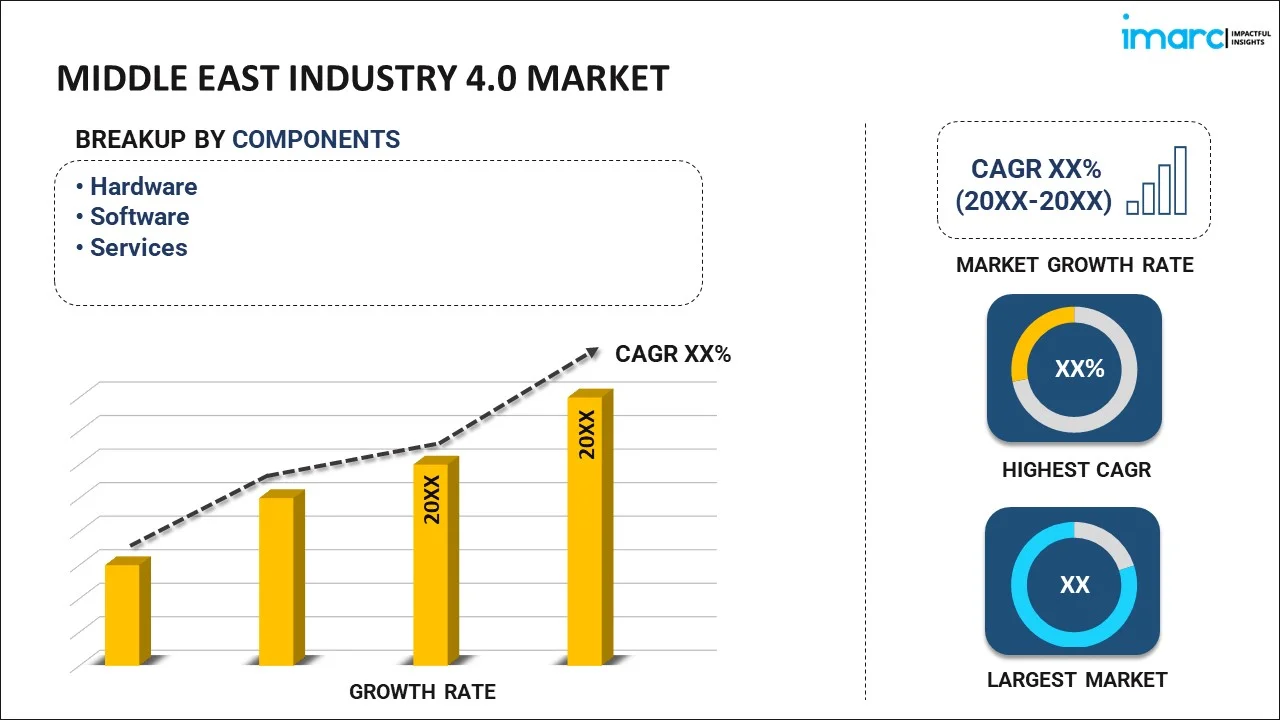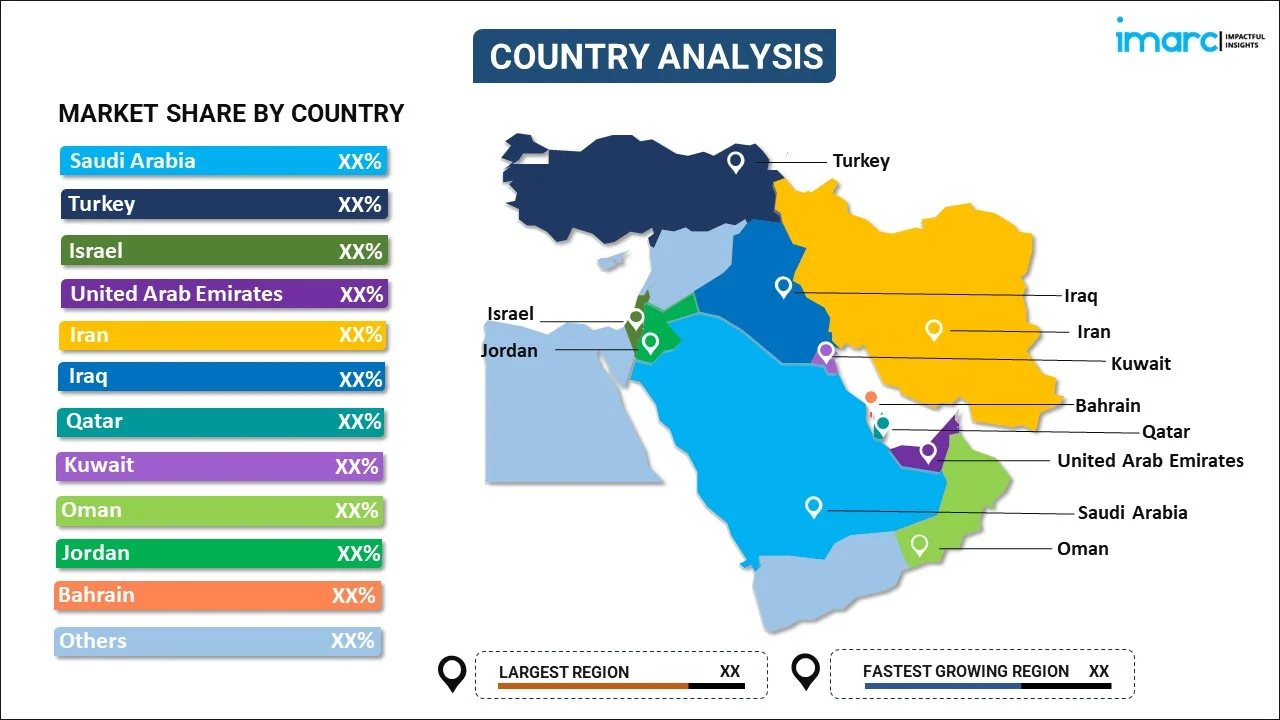
Middle East Industry 4.0 Market Report by Component (Hardware, Software, Services), Technology Type (Industrial Robotics, Industrial IoT, AI and ML, Blockchain, Extended Reality, Digital Twin, 3D Printing, and Others), End Use Industry (Manufacturing, Automotive, Oil and Gas, Energy and Utilities, Electronic and Foundry, Food and Beverages, Aerospace and Defense, and Others), and Country 2024-2032
Market Overview:
Middle East industry 4.0 market size is projected to exhibit a growth rate (CAGR) of 20.87% during 2024-2032. continuous advancements in technologies, such as artificial intelligence (AI), the Internet of Things (IoT), and robotics, represent some of the key factors driving the market.
|
Report Attribute
|
Key Statistics
|
|---|---|
|
Base Year
|
2023 |
|
Forecast Years
|
2024-2032
|
|
Historical Years
|
2018-2023
|
| Market Growth Rate (2024-2032) | 20.87% |
Industry 4.0 signifies a revolutionary transformation in manufacturing and industrial practices, involving the incorporation of digital technologies, automation, data analytics, and the Internet of Things (IoT) across diverse industrial operations. This shift is fundamentally reshaping the operational landscape of businesses and their approaches to production. Within the framework of industry 4.0, machines and systems engage in communication and collaboration with minimal human intervention, resulting in heightened efficiency and productivity. In line with this, the emphasis on data-driven decision-making, enabled by the real-time collection and analysis of data, empowers companies to optimize their processes, mitigate downtime, and elevate the quality of their products. Moreover, industry 4.0 fosters sustainability by curbing resource wastage, aligning with a broader commitment to environmentally conscious practices.
Middle East Industry 4.0 Market Trends:
The Middle East industry 4.0 market is undergoing a transformative phase, marking a significant shift in the region's manufacturing and industrial landscape. Additionally, the elevating integration of digital technologies, automation, data analytics, and the Internet of Things (IoT) into a diverse array of industrial processes is acting as another significant growth-inducing factor. Besides this, companies in the Middle East are adopting smart manufacturing practices where machines communicate and collaborate with minimal human intervention, leading to heightened operational efficiency and increased productivity, which is positively influencing the regional market. Moreover, the utilization of real-time data collection and analysis is a key aspect, enabling data-driven decision-making and allowing businesses to optimize their operations, reduce downtime, and elevate product quality. In addition to enhancing operational performance, the Middle East industry 4.0 market is also contributing to sustainability goals by minimizing resource wastage. This transition towards advanced manufacturing technologies aligns with the broader emerging trends of environmentally conscious practices. The region's commitment to technological innovation and digitalization is anticipated to fuel the market growth over the forecasted period.
Middle East Industry 4.0 Market Segmentation:
IMARC Group provides an analysis of the key trends in each segment of the market, along with forecasts at the regional and country levels for 2024-2032. Our report has categorized the market based on component, technology type, and end use industry.
Component Insights:

- Hardware
- Software
- Services
The report has provided a detailed breakup and analysis of the market based on the component. This includes hardware, software, and services.
Technology Type Insights:
- Industrial Robotics
- Industrial IoT
- AI and ML
- Blockchain
- Extended Reality
- Digital Twin
- 3D Printing
- Others
A detailed breakup and analysis of the market based on the technology type have also been provided in the report. This includes industrial robotics, industrial IoT, AI and ML, blockchain, extended reality, digital twin, 3D printing, and others.
End Use Industry Insights:
- Manufacturing
- Automotive
- Oil and Gas
- Energy and Utilities
- Electronic and Foundry
- Food and Beverages
- Aerospace and Defense
- Others
The report has provided a detailed breakup and analysis of the market based on the end use industry. This includes manufacturing, automotive, oil and gas, energy and utilities, electronic and foundry, food and beverages, aerospace and defense, and others.
Country Insights:

- Saudi Arabia
- Turkey
- Israel
- United Arab Emirates
- Iran
- Iraq
- Qatar
- Kuwait
- Oman
- Jordan
- Bahrain
- Others
The report has also provided a comprehensive analysis of all the major regional markets, which include Saudi Arabia, Turkey, Israel, United Arab Emirates, Iran, Iraq, Qatar, Kuwait, Oman, Jordan, Bahrain, and Others.
Competitive Landscape:
The market research report has also provided a comprehensive analysis of the competitive landscape in the market. Competitive analysis such as market structure, key player positioning, top winning strategies, competitive dashboard, and company evaluation quadrant has been covered in the report. Also, detailed profiles of all major companies have been provided.
Middle East Industry 4.0 Market Report Coverage:
| Report Features | Details |
|---|---|
| Base Year of the Analysis | 2023 |
| Historical Period | 2018-2023 |
| Forecast Period | 2024-2032 |
| Units | US$ Million |
| Scope of the Report | Exploration of Historical and Forecast Trends, Industry Catalysts and Challenges, Segment-Wise Historical and Predictive Market Assessment:
|
| Components Covered | Hardware, Software, Services |
| Technology Types Covered | Industrial Robotics, Industrial IoT, AI and ML, Blockchain, Extended Reality, Digital Twin, 3D Printing, Others |
| End Use Industries Covered | Manufacturing, Automotive, Oil and Gas, Energy and Utilities, Electronic and Foundry, Food and Beverages, Aerospace and Defense, Others |
| Countries Covered | Saudi Arabia, Turkey, Israel, United Arab Emirates, Iran, Iraq, Qatar, Kuwait, Oman, Jordan, Bahrain, Others |
| Customization Scope | 10% Free Customization |
| Report Price and Purchase Option | Single User License: US$ 3699 Five User License: US$ 4699 Corporate License: US$ 5699 |
| Post-Sale Analyst Support | 10-12 Weeks |
| Delivery Format | PDF and Excel through Email (We can also provide the editable version of the report in PPT/Word format on special request) |
Key Questions Answered in This Report:
- How has the Middle East industry 4.0 market performed so far and how will it perform in the coming years?
- What has been the impact of COVID-19 on the Middle East industry 4.0 market?
- What is the breakup of the Middle East industry 4.0 market on the basis of component?
- What is the breakup of the Middle East industry 4.0 market on the basis of technology type?
- What is the breakup of the Middle East industry 4.0 market on the basis of end use industry?
- What are the various stages in the value chain of the Middle East industry 4.0 market?
- What are the key driving factors and challenges in the Middle East industry 4.0?
- What is the structure of the Middle East industry 4.0 market and who are the key players?
- What is the degree of competition in the Middle East industry 4.0 market?
Key Benefits for Stakeholders:
- IMARC’s industry report offers a comprehensive quantitative analysis of various market segments, historical and current market trends, market forecasts, and dynamics of the Middle East industry 4.0 market from 2018-2032.
- The research report provides the latest information on the market drivers, challenges, and opportunities in the Middle East industry 4.0 market.
- Porter's five forces analysis assist stakeholders in assessing the impact of new entrants, competitive rivalry, supplier power, buyer power, and the threat of substitution. It helps stakeholders to analyze the level of competition within the Middle East industry 4.0 industry and its attractiveness.
- Competitive landscape allows stakeholders to understand their competitive environment and provides an insight into the current positions of key players in the market.
Need more help?
- Speak to our experienced analysts for insights on the current market scenarios.
- Include additional segments and countries to customize the report as per your requirement.
- Gain an unparalleled competitive advantage in your domain by understanding how to utilize the report and positively impacting your operations and revenue.
- For further assistance, please connect with our analysts.
 Inquire Before Buying
Inquire Before Buying
 Speak to an Analyst
Speak to an Analyst
 Request Brochure
Request Brochure
 Request Customization
Request Customization




.webp)




.webp)












